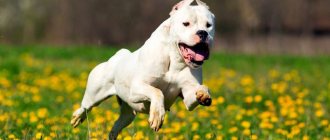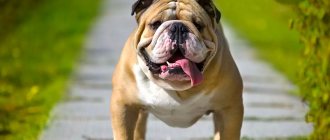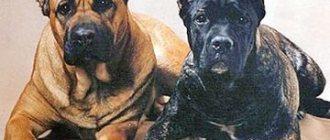The character of a dog depends on heredity and breed characteristics, but proper upbringing and training is also of no small importance. In this article we will tell you about the natural characteristics of the breed and how to properly start raising and training your pet.
German Boxers are excellent watchdogs. Dogs of this breed are famous for their fearless and balanced character. Boxers become attached to their family and, if properly trained, get along well with all family members and other animals. They are suspicious of strangers. They are also good as a companion dog and family dog.
- Country of origin : Germany
- Height at withers : males 57-63 cm, females 53-59 cm
- Weight : males ~30 kg, females ~25 kg
- Lifespan : 11-12 years
- Use : companion dog, service dog, guard
Content
- The main character traits of a German boxer: female or male?
- Character of a German boxer
- Basic commands
- Raising a dog
In this article you will learn what features of character and behavior are inherent in the German boxer. After studying this information about the temperament and disposition of a German boxer at different ages, you will get an idea about the breed. Find out how the character of a bitch differs from the behavior of a dog. We hope our article will help you figure out which gender of puppy is best for you.
The main character traits of a German boxer: female or male?
The German Boxer puppy is an active and restless pet. If you take care of and train your puppy, you can avoid pampering. Constant damage to things does not indicate the baby’s bad character, he is just very active and needs somewhere to throw out his energy. You can buy toys for him, he will be active with them, direct his energy to playing with them. Already from 3-4 months (the time of socialization), he is able to perceive the general rules of education. At this time, it is important to begin socializing and training the dog.
Bitch: character
There is an opinion that German Boxer bitches have a more submissive and gentle character. But experts believe that character largely depends on heredity and individual characteristics. There are always exceptions, bitches with a very difficult character, and there are males with an easy-going and submissive character. But still, there is a difference in the behavior of the sexes. There are advantages and disadvantages for female and male genders.
Advantages:
- Strong relationship with owner and home
- Emotionally sensitive perception
- Girls are smarter and smarter than boys
- Accepts training tasks well
- During walks, he runs less in the bushes
- Doesn't rush at strangers
- The breed is ideal for breeding, just one assessment from the exhibition is enough
Flaws:
- Sly
- Periodic menstruation
Breed standard
German Boxers are medium-sized dogs. Representatives of the breed are characterized by a stocky build, dry muscles with a clearly protruding relief under the coat. Males weigh from 27 to 32 kilograms, height at the withers is up to 63 centimeters. Bitches are more miniature: weight 25-29 kg, height - 53-60 cm.
Appearance characteristics:
- The head is compact, square with a massive protruding forehead. The muzzle is flattened, with a dark mask.
- The nose is upturned, black with wide nostrils.
- The eyes are small, almond-shaped, dark.
- The jaws are powerful. The lower one protrudes forward, which gives the dog a warlike appearance. The teeth are strong and symmetrically spaced. The form of the bite is an undershot.
- The lips (brows) are thick and fleshy.
- The ears are set high.
- The body is square, the loin and back are strong and short.
- The limbs are correctly placed and massive.
- The croup is wide, the belly is lean, fully tucked.
- The coat is short, hard, lying close to the body.
- The skin is dry, elastic, without wrinkles.
According to the standard, German boxers have two colors - brindle and red. Grey, black and others are considered defective. White markings on the coat are allowed and give the exterior a more aesthetic appearance.
Male: character
Advantages:
- High performance, very durable
- Solid appearance, a big plus for exhibitions
- Persistence in achieving results in the learning process
Flaws:
- Independent and more stubborn than a girl. Requires more strict training than a girl.
- To fulfill your physical and natural needs, you need a longer time for walks. According to physiology, he is not capable of quickly emptying the bladder.
- Can run away from its owner if it smells a female in heat.
- During the period of estrus in females, fights with other males are possible.
Is it possible to influence and correct the character of the German boxer?
Raising and training a German boxer is of great importance, as soon as you bring him into your home. Do not allow people to chew things, stop attempts to pester strangers while walking, do not allow them to eat from someone else’s hands, pick up food from the floor, or beg for food from you while eating. It is forbidden to jump on and bite people, even to show your love. Only training and proper upbringing will change a dog’s character for the better. The puppy training process is based on the method of motivation, encouragement and praise. It is prohibited and unacceptable to treat the dog harshly during training.
German boxer character
The German boxer has a balanced character, self-confident, fearless and calm. The dog's character is a very important parameter and requires special attention. For a long time, the boxer has been famous for its loyalty and devotion to its owner and his family, as well as for its vigilance and fearlessness as a protector. is suspicious of strangers and very affectionate with all family members. Friendly and playful in play, but fearless in attack. Easy to train. The Boxer is an excellent companion and family member and serves as a companion and protector in the home.
Features of care
German boxers are an unpretentious breed. Even an inexperienced dog owner can take care of it.
Particular attention should be paid to the skin on the face. The folds and nose are wiped daily to remove any remaining food and moisture.
The wool is combed 1-2 times a week using a silicone or rubber brush. Brushing has a relaxing effect, improves blood circulation, removes dirt and dead hair. The dog should be accustomed to the procedure from a very early age.
There is no need to bathe Boxers often; it is enough to do it once every six months. Unscheduled swimming is organized only in cases of heavy pollution. The water for washing should not be hot - no higher than 32 degrees. For hair care, it is advisable to use special shampoos with a low pH level.
After a walk, the Boxer's paws are wiped with a damp cloth and examined for scratches, abrasions, and cuts. Their pads are quite strong, but nevertheless they are often injured.
Regular nail trimming (once a week) will relieve your pet from discomfort when walking and prevent curvature of the nail plate.
German boxers feel comfortable in a private home and apartment. Despite their rather large size and hyperactivity, dogs have very modest requirements for housing dimensions. If the dog is kept in an apartment, then the duration of walks should be increased.
When walking in cold weather, it is advisable to wear warm clothing, such as a vest, on your Boxer. Dogs are prone to colds, and short hair protects against the cold only if they are highly mobile.
How to raise a German Boxer puppy
If you train your pet correctly, then over time you will get an obedient dog that will follow all commands and delight you every day. Experts believe that several factors may influence a German boxer’s sensitivity to various commands:
- pet's temperament - the speed of the pet's reaction to stimuli, both positive and negative;
- character - how exactly the dog resists various unpleasant influences;
- obedience - the dog’s ability to accept human leadership;
- vigilance - the speed with which the dog notices potential danger, both in relation to itself and in relation to the owner;
- aggressiveness - the pet’s ability to react hostilely to potential danger;
- curiosity - interest that is developed when a dog feels, hears and sees something;
- sociability - the ability to interact with people;
- possessiveness is the interest shown by animals in certain objects, for example toys.
How quickly your dog will learn commands depends on what specific traits predominate in the character of a German Boxer puppy. By paying attention to the character traits of your animal, you can find an approach to it and adjust its behavior in certain situations.
- Eagerness will get you nowhere . You should not try to teach your German Boxer puppy all the commands at the same time; you need to learn the commands one by one. You need to have patience and act methodically. You should not scold your pet at the moment when he makes mistakes, and when he succeeds in something, then the pet should be encouraged.
- Don't hit . It is prohibited to use physical punishment against a pet. You should limit yourself to variable intonation, but avoid shouting. Once a German Boxer puppy is three months old, it is legal to use a light spank while saying “Ew” as punishment. It is necessary to punish immediately when the animal commits an offense, and not after it, since the animal simply will not understand what exactly it was punished for.
- Subsequence . The main goal is to ensure that the pet follows the command the first time. Commands should be pronounced clearly and in an even voice so that the dog understands and obeys you. All family members should be involved in raising the dog, but they must act together. It is forbidden to allow situations in which you scold the puppy, and another family member praises him or simply does not pay attention.
- Pamper . Remember to reward your German Boxer puppy with a variety of treats and praise when he has done what is asked of him.
Character
The character of German boxers is good-natured and cheerful, they are loyal and devoted. Representatives of this breed are distinguished by excellent mental abilities and protective qualities. There is an opinion that boxers are stupid and difficult to train. This is completely untrue, because even inexperienced dog breeders are recommended to own the breed.
Training still has a number of features. Boxers remain emotionally immature for a long time, so it may seem that they are unteachable. However, at one moment the dog suddenly understands what they want from him and successfully demonstrates all the skills that were instilled in him.
You shouldn’t succumb to charm and spontaneity: for the sake of a treat, a pet can resort to cunning, and it’s no wonder it gets spoiled.
The character of boxers invariably contains a functional instinct - the spirit of fight. From an early age, dogs enjoy fighting, fight with joy and selflessly, in this way they splash out emotions and demonstrate strength. However, if you satisfy the dog's demands too often and allow him to fight, he can grow up pugnacious. With proper upbringing, a boxer calculates his strength and uses it exclusively in times of danger.
Dogs are infinitely devoted to their family, adore small children and are ready to endure all their pranks. Representatives of this breed tend to protect the weak, so they will never touch children and will forgive them any awkwardness, even if it causes pain.
Boxers have a hard time being separated from their loved ones and easily adapt to new living conditions. They do not show aggression towards strangers, but do not let them out of sight. In times of danger, smart and fearless boxers will show fighting qualities and protect their owner, even at the cost of their own lives.
Basic commands
You will use some commands more often, others less often. But they will still be useful to easily interact with the German boxer and even protect him in various situations.
- Aport. One of the most difficult teams. Many people perceive it as very easy and simple, but with many dogs you will have to work hard. This skill is used for other exercises: searching, searching, selecting an item and many others. Usually they are all used in service. When working out a command, “Aport” and “Give” are used, and a gesture is also used.
- Give. On the command “Give” the dog must give up the object.
- Lie. A connecting command that needs to be learned for other commands. In addition, it will not interfere at home or on the street.
- To me. You will need to use this command quite often. So start with it immediately after your German Boxer puppy has learned his name. Never call the dog to punish, and do not scold if it comes on its own, even after mischievousness before it. This behavior on your part may alienate the animal.
- Place. A puppy or an adult dog must clearly know where his place is located. He can sleep anywhere, if you allow it, of course, but he must know this command. You can use it outside the home, marking the place with a leash or your favorite toy.
- Near. It is possible to teach your pet the “Near” command at any age, be it an adult dog or a small puppy. When you move to a new home, you should immediately think about training your puppy.
- Sit. One of the very first commands that a German boxer puppy should learn.
- Stand. The command is useful in everyday life, for example, for combing a dog.
- . The prohibiting command is one of the most mandatory and taming it begins from the first day the puppy appears in the house. Requiring the command “Fu!”, “No!”, “No!” - immediately stop the unwanted action.
Origin of the breed
It is believed that the ancestors of German boxers were Bullenbeissers, living in Central and Western Europe. Having relatively small dimensions, they were distinguished by extraordinary mobility and fearlessness. These qualities made it possible to use them for hunting large animals and baiting bulls. Dogs similar to modern German boxers are found in 17th-century images.
The first specimens were bred in 1850 in Munich. Mastiffs, Bullenbeisers and bulldogs were used in breeding work - dogs distinguished by rare courage and excellent fighting qualities. The final formation of German boxers dates back to 1896, when producers managed to obtain a breed that combines strength and power, developed intelligence and healthy aggression. In the same year, the first club of fans of German boxers was created and the standard was approved.
The representatives of the breed got their name because of the unusual way they play, moving their paws in the air, as if imitating a fight in the ring.
Raising a dog
Education is the process of shaping the behavior of a German boxer acceptable to the owner, when this behavior is not regulated by teams.
During upbringing, a dog develops relationships with its owner, family members, passers-by, behavior in the house, on the street, and relationships with other dogs. The training process begins immediately when the dog first appears in the house and continues throughout the dog’s life. Regardless of the dog's breed, it must be trained. Just as people do not like ill-mannered people, dogs should also know what is allowed and what is not allowed. Raising a dog is a rather complex process, which is not limited to learning just a few commands. The main goal of education is that the dog should become pleasant to talk to. In addition, it must be manageable at some points, otherwise it will be very difficult for the dog owner. In the broadest sense of the word, dog training is about teaching the dog commands such as “Bad” and “No”. But besides this, the dog must know what is good and what is bad, even in those moments when the owner is not around. Some believe that the German boxer only understands commands, but cannot generalize. Only those who, as a rule, never had dogs, and studied them only in laboratory conditions, in which dogs were not able to show their full potential, are convinced of this, as well as those who, due to their personal qualities, were unable to establish a relationship with pet. In real life, the German boxer is a pack animal and therefore, like any other pack animal, needs to communicate with members of its family. In this situation, the dog’s family members are people. It is quite stupid to think that if a dog caresses you, this means that his skin is itching. In order for a dog’s nervous system to function normally, it needs affection, love, communication, and praise. In addition, so-called “inhibiting factors” are required, because if the dog is allowed everything, then this will not lead to anything good. When raising a German Boxer puppy, you should pay attention to the genetic characteristics of the breed. A family is a pack in which there must be a leader, in this case the leader is a person. The leader punishes, plays, feeds, caresses, praises and scolds. All other members of the owner's family are ranked by rank. At that moment, while the puppy is small, all other family members are senior to him. However, in the process of growing up, around the age of one year, the dog begins to look for its place in the hierarchical pyramid. Naturally, she will try to take the step that is as high as possible. She can do this with the help of force, in the case of large dogs, or with the help of cunning, as small dogs do. The more ill-mannered the dog is, the more difficult this process will be. If the owner from the first days shows his pet that the one who has the power is right, then he will turn out to be a frail neurotic or an evil beast with whom you will hardly communicate with joy. A German boxer puppy must understand that he must obey people, since they love him, feed him, and raise him. Understand that prohibitions are not the whim of the owner, but a way to protect everyone from trouble. The main influence on the dog should be the voice. From the first days of being in your home, the puppy must realize that you love him, and if you raise your voice, then this means that he is doing something wrong. One of the best incentives for a pet is considered to be a treat, which should be given out for good behavior and listening to commands. The character of the German boxer: who is better to take a bitch or a dog?
Health, typical diseases
German boxers cannot be considered long-livers, since they rarely reach the age of 10 years. The immunity of representatives of this breed is not very strong, so they often become hypothermic and are prone to colds, allergies, and demodicosis.
A common condition in Boxers is hip dysplasia, which is characterized by pain and lameness. In advanced cases it leads to complete immobilization. The pathology is difficult to treat and surgical intervention is most often indicated.
Boxers are often diagnosed with brachiocephalic syndrome, which is characterized by hoarse breathing, shortness of breath, and severe snoring during sleep. The reason is the structure of the muzzle. Breathing problems and asthma attacks worsen during intense workouts and in hot weather. Treatment is surgical.
Like other large dogs, Boxers are prone to overeating, so food intake must be controlled. Gluttony leads to gastric volvulus and other pathologies, which can only be eliminated surgically.
The most well-known disease in Boxers is hypothyroidism. Thyroid dysfunction significantly reduces the quality of life, contributes to deterioration of appearance, leads to infertility and obesity. To eliminate the disease, replacement therapy is prescribed.
Congenital diseases of Boxers include eversion (entropion) of the eyelid, which is corrected surgically. Puppies whose color is predominantly white are often diagnosed with complete or partial deafness (up to 40% of individuals).
German boxers are prone to cardiac diseases, the most common of which are arrhythmogenic right ventricular cardiomyopathy and aortic stenosis.
In old age, boxers often develop cancer, and this fact is also due to a weak immune system. According to veterinarians, this is one of the most susceptible breeds to the development of malignant neoplasms.











